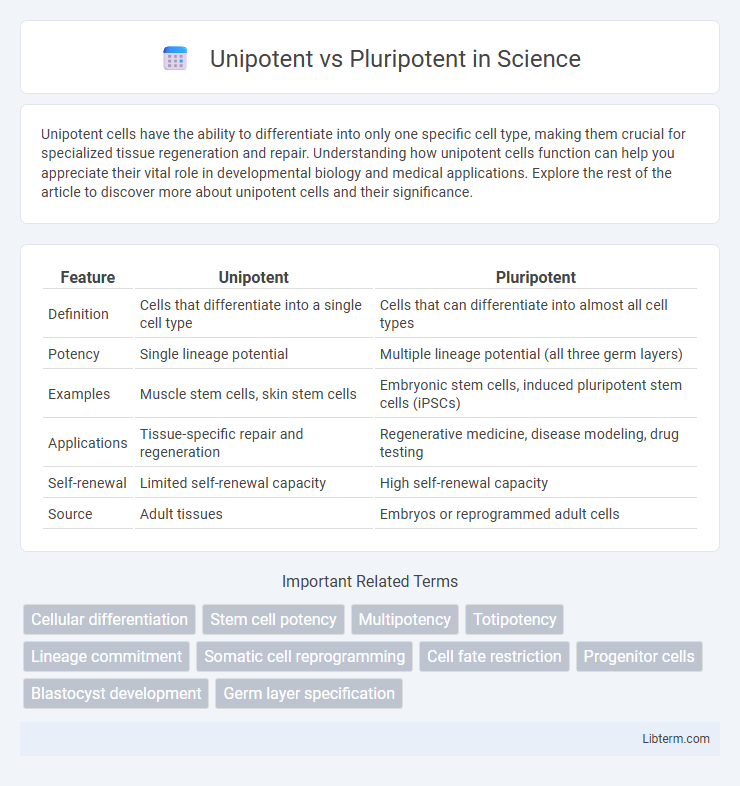Unipotent cells have the ability to differentiate into only one specific cell type, making them crucial for specialized tissue regeneration and repair. Understanding how unipotent cells function can help you appreciate their vital role in developmental biology and medical applications. Explore the rest of the article to discover more about unipotent cells and their significance.
Table of Comparison
| Feature | Unipotent | Pluripotent |
|---|---|---|
| Definition | Cells that differentiate into a single cell type | Cells that can differentiate into almost all cell types |
| Potency | Single lineage potential | Multiple lineage potential (all three germ layers) |
| Examples | Muscle stem cells, skin stem cells | Embryonic stem cells, induced pluripotent stem cells (iPSCs) |
| Applications | Tissue-specific repair and regeneration | Regenerative medicine, disease modeling, drug testing |
| Self-renewal | Limited self-renewal capacity | High self-renewal capacity |
| Source | Adult tissues | Embryos or reprogrammed adult cells |
Understanding Stem Cell Potency
Unipotent stem cells have the ability to differentiate into only one specific cell type, making them highly specialized but limited in scope. Pluripotent stem cells can develop into almost any cell type in the body, excluding extra-embryonic tissues, offering greater versatility for regenerative medicine. Understanding the distinction between unipotent and pluripotent potency is crucial for developing targeted therapies and advancing tissue engineering.
What Are Unipotent Stem Cells?
Unipotent stem cells are specialized cells capable of differentiating into only one cell type, playing a critical role in tissue repair and regeneration. Unlike pluripotent stem cells, which can develop into nearly any cell type in the body, unipotent stem cells have a limited differentiation potential but possess the ability for self-renewal. These cells are essential for maintaining homeostasis in specific tissues such as muscle, skin, and liver.
What Are Pluripotent Stem Cells?
Pluripotent stem cells possess the unique ability to differentiate into nearly all cell types derived from the three germ layers: ectoderm, mesoderm, and endoderm. Unlike unipotent stem cells, which can generate only one specific cell type, pluripotent stem cells provide broad therapeutic potential for regenerative medicine and tissue engineering. Sources of pluripotent stem cells include embryonic stem cells and induced pluripotent stem cells (iPSCs), both critical for advanced cell therapy and disease modeling.
Key Differences: Unipotent vs Pluripotent
Unipotent cells can differentiate into only one specific cell type, making them highly specialized, whereas pluripotent cells have the ability to differentiate into almost any cell type in the body, excluding extraembryonic tissues. Unipotent stem cells primarily support tissue maintenance and repair within a specific lineage, while pluripotent stem cells are crucial for embryonic development and regenerative medicine due to their broader differentiation potential. The key differences between unipotent and pluripotent cells lie in their differentiation capacity, role in development, and therapeutic applications.
Biological Roles and Functions
Unipotent stem cells have a limited biological role, primarily differentiating into a single cell type to maintain and repair specific tissues, such as muscle or skin. Pluripotent stem cells exhibit extensive functionality by giving rise to nearly all cell types derived from the three germ layers: ectoderm, mesoderm, and endoderm, enabling their critical role in early embryonic development and regenerative medicine. The distinct differentiation potential of unipotent versus pluripotent cells defines their unique contributions to tissue homeostasis and therapeutic applications.
Applications in Regenerative Medicine
Unipotent stem cells are primarily used in regenerative medicine for tissue-specific repair, such as skin grafts and muscle regeneration, due to their ability to differentiate into a single cell type. Pluripotent stem cells, including embryonic stem cells and induced pluripotent stem cells, offer broader therapeutic potential by differentiating into nearly all cell types, enabling treatments for complex diseases like Parkinson's, diabetes, and heart failure. The versatility of pluripotent stem cells makes them crucial for developing cell-based therapies and organ regeneration, while unipotent stem cells provide targeted healing within specialized tissues.
Advantages of Unipotent Stem Cells
Unipotent stem cells offer significant advantages due to their ability to differentiate into a single cell type, ensuring targeted and efficient tissue regeneration with minimal risk of unwanted cell types forming. Their restricted differentiation potential reduces the likelihood of tumor formation compared to pluripotent stem cells, making them safer for therapeutic applications. Moreover, unipotent stem cells often exhibit greater stability and easier isolation from adult tissues, facilitating practical and scalable use in regenerative medicine.
Advantages of Pluripotent Stem Cells
Pluripotent stem cells offer the distinct advantage of differentiating into nearly all cell types, providing extensive potential for regenerative medicine and tissue engineering. Their ability to self-renew indefinitely in vitro enables large-scale production for research and therapeutic applications. Unlike unipotent stem cells, pluripotent cells can address complex diseases by generating diverse specialized cells, enhancing treatment versatility and effectiveness.
Ethical and Safety Considerations
Unipotent stem cells, limited to differentiating into a single cell type, present fewer ethical concerns and lower risks of tumorigenesis compared to pluripotent stem cells, which can develop into any cell type but raise ethical debates due to their derivation from embryos. The use of pluripotent stem cells, such as embryonic stem cells or induced pluripotent stem cells (iPSCs), involves complex safety issues including potential genetic instability and immune rejection, necessitating rigorous screening protocols. Ethical considerations surrounding pluripotent stem cells emphasize the moral status of embryos and consent, whereas unipotent stem cells typically involve fewer societal and regulatory challenges.
Future Perspectives in Stem Cell Research
Unipotent stem cells, with their limited differentiation capacity, offer targeted therapeutic applications, especially in tissue-specific regeneration and repair. Pluripotent stem cells, capable of giving rise to any cell type, hold immense promise for personalized medicine, disease modeling, and drug discovery due to their broad differentiation potential. Advances in gene editing and biomaterials are expected to enhance the clinical translation of both stem cell types, driving innovative treatments for complex diseases and regenerative therapies.
Unipotent Infographic

 libterm.com
libterm.com